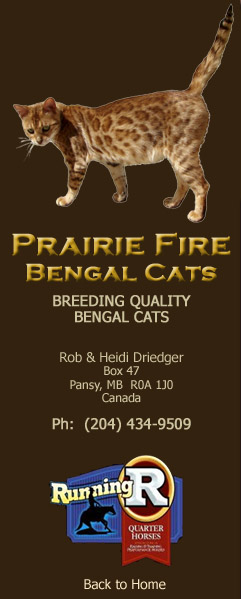
About Bengal Cats

Bengal – a man made breed of cat that has come about by crossing the Asian Leopard Cat and a domestic short haired tabby. Bengals that are F4 or four generations removed, are eligible to compete in shows and are considered SBT. Ancestors prior to F4 are considered Filial or Foundation stock.
Bengals have a sleep, muscular look. They should have beautiful large eyes, a straight profiled nose and small rounded ears. You can find more information on the specific built of the cat by reading the Type or Confirmation definition.
Bengals are very social beings! They love to be where you are and if they fall asleep while they are spending time with you, they will look for you when they wake up should they find the room empty!
Generally, they are fond, or at the very least tolerant of water. They are often found playing in their water dish, or heaven forbid, the toilet! They’ve been known to jump into the tub or pool!
ALC or ASIAN LEOPARD CAT: The Asian Leopard Cat (ALC) is the ancestor the Bengal Cat. The ALC lives in forests all over south-east Asia. They live near streams so they are quite comfortable with water. ACLs are one of the smartest types of felines. They feed on a variety of things such as; insects, rodents, birds, fish, and amphibians. They are beautiful cats that seem to have a “wild” streak in them, as they are nearly impossible to tame.
These nocturnal cats range in weight from 5 lbs – 15 lbs, depending on their gender and subspecies. The ACLs in the south are preferable for breeding due to their lack of ticking, where as the northern ACLs can produce ticking in their offspring and thus, dull the coat. ACLs can have rosetting; from solid spots to arrowhead in shape.
ACLs genetically “match” domestic cats, and through years of trials and breeding, we have the breed called BENGAL.
Coat – Bengals have an extremely soft short coat – sometimes compared to the softness of chinchillas or rabbits. There are a variety of colours that Bengals can produce; such as various shades of brown, sliver and snow. Spots, rosettes and marble patterns can be found on Bengals as well in the previously mentioned colors. We have found that may people that would normally be allergic to cat dander have less or no reaction or Bengal dander. I, personally, am allergic to domestic cats, but not to Bengals.
Filial: This refers to the hybrid generations 1-3 found in the very beginning of the Bengal breed. Their abbreviations are: F1, F2 and F3. Our Bengals are F7 or higher.
Foundation: According to T.I.C.A., foundation refers the generations F1 through F3 stock of Bengals. It gets confusing because Filial ALSO refers to the F1 through F3 stock, however, T.I.C.A. doesn’t recognize Filial as an official term to describe F1-F3. Foundation, outside of T.I.C.A.’s jurisdiction, generally refers to ANY Bengal stock, ALC, F1, F2, F3 or even SBT that has been a part of a breeder’s initial breeding program.
Fuzzies: This is a stage in development in which longer hairs grow from Bengal kittens’ coat. This stage starts around the 4 ½ - 7 week range. These longer hairs seems to dull the coat and produces a loss of contrast in colour. But it only lasts for a few weeks or months. It is the beginning of a sleeker, more mature coat later on.
Glitter: This refers to the individual hair shafts that are gold in color. This “glitter” runs throughout the pelt. This is a unique trait of the Bengal breed and it makes it look like the cat has been sprinkled with gold.
Pelt: This refers to the soft coats that Bengals have. It shows up the beautiful contrasted markings of Bengals.
Rib Bars or Barring or Mackereling: Refers to the stripes or spots that are vertically connected on the torso of the cat. It is best that even the legs should be spotted, not barred, as it looses points in the show ring. However, barring does NOT affect the wonderful personalities of Bengals!
Rosettes: This refers to the wonderful patterns that are found on Bengals, particularly referring to the shape (arrowhead, paw print or donut) with a darker color around the shape with a lighter color in the centre. Rosettes can be as small as dots and as large as “pancake” looking blobs. They are one of the striking feature of Bengals.
Rufus: This refers to the reddish background color of the cat.
S.B.T.:“Stud Book Tradition” or SBT is a term that states that the Bengal cat is 4 generations removed from the Asian Leopard Cat. To be an SBT only Bengal to Bengal breeding is allowed, meaning no outcrosses are acceptable.
T.I.B.C.S.– “The International Bengal Cat Society” founded by Gene Ducote of Gogees.
T.I.C.A.: “The International Cat Association”
Ticking: This refers to the multicolors found on a single hair. A Bengal that has ticking may have a less contrasted look.
Type or Confirmations: This refers to the standard to which the body structure is compared to. It includes standards of how the head is set, ear set, eye and tail set, the form of legs, width of chest, length of neck etc.
White Tummy: This refers to the area under the neck, chest, as well as the under side of the torso to the inside of the legs that are to be white.
Wild Head or Wild Face: This refers to the large round eyes, small round eats, puffy whisker pads, wide nose with no “nose break” meaning it is quite straight, and white around the eyes and muzzle area – Jean Mills.